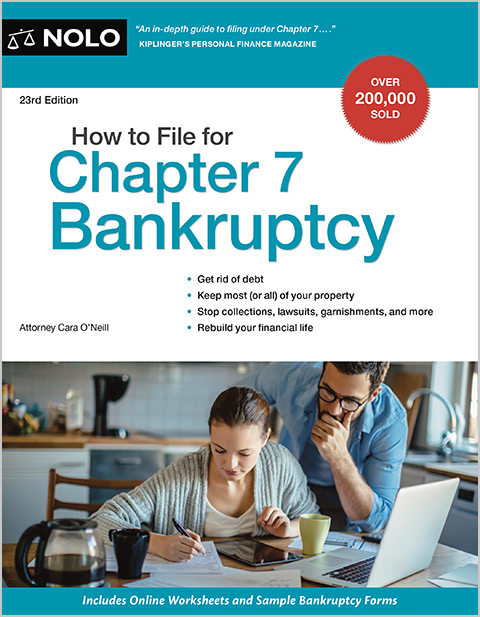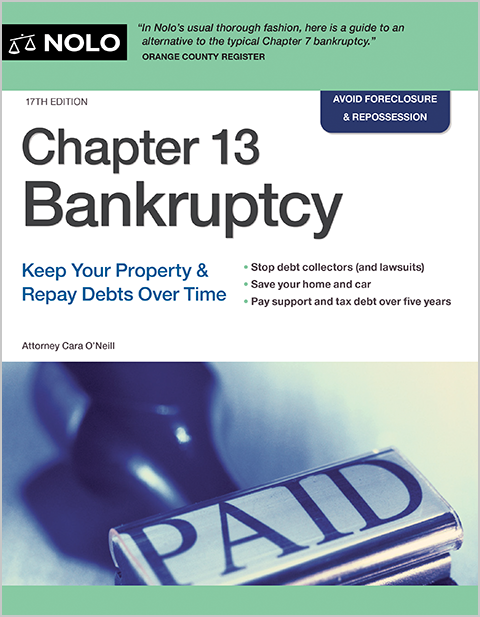Learn how to keep your car, reduce your car loan, and avoid repossession in Chapter 13 bankruptcy.
Chapter 13 bankruptcy offers benefits that can help you keep your vehicle. If you're behind on your car loan payments, you can catch up through your Chapter 13 plan. Even better, if you owe more on your car loan than the car is worth, you might be able to reduce the amount owed.
But sometimes, keeping a vehicle in Chapter 13 bankruptcy isn't feasible. For instance, it might not be possible to keep your car if:
- you have a lot of nonexempt car equity (equity you can't protect with a bankruptcy exemption)
- your car payment is exceptionally high, or
- you're making payments on a second vehicle that you don't need.
We also explain when you can use Chapter 13 to recover a repossessed car and what you'll do if you need to finance another vehicle during Chapter 13 bankruptcy. If you're considering filing Chapter 7, you'll want to learn about keeping a car in Chapter 7.
- How Chapter 13 Can Help With a Vehicle
- Keeping a Vehicle in Chapter 13: What You'll Need to Do
- Chapter 13 and Auto Loans: Proving You Can Afford the Payment
- What Happens If Your Car Is Paid Off in Chapter 13?
- Can I File Chapter 13 and Get My Repossessed Car Back?
- Can I Buy Another Car During My Chapter 13 Bankruptcy Case?
- Need More Bankruptcy Help?
How Chapter 13 Can Help With a Vehicle
Chapter 13 bankruptcy offers several benefits to help you keep or get out from under your property. Here are a few that apply to vehicles.
- You can stop repossession. When you file for Chapter 13 bankruptcy, most creditors must stop any collection efforts against you because of an order called the "automatic stay." A car lender can't repossess your car if you've already filed for Chapter 13 bankruptcy. In some cases, you can even get a car back if the lender repossessed it shortly before you filed for Chapter 13. Find out more about car repossessions and Chapter 13 bankruptcy.
- You can give a car back to the bank. If you have a car payment that you can't afford, or you're making payments on a car that's unreliable or needs costly repairs, it might make sense to let it go. In Chapter 13, you can get out from under the payment by surrendering the vehicle.
- You can catch up on your car payment. If you're behind on your car loan or lease and you file for Chapter 13 bankruptcy, you can keep your car if you pay the amount you're behind through your repayment plan and continue to make your regular car payments. The lender cannot repossess your car if you stay current on your car loan and repayment plan.
- You might be able to reduce your car loan. If the amount of your car loan is more than the value of your car, which isn't uncommon because cars depreciate quickly, you might be able to reduce or "cram down" your loan amount in Chapter 13 bankruptcy. Essentially, you can reduce the amount you owe to equal the car's value. Whatever is left becomes unsecured debt and is treated like your other unsecured debts. The catch is your jurisdiction might have another rule, such as requiring you to have bought the car more than two and a half years before the bankruptcy filing. Learn more about car loan cramdowns in bankruptcy.
Keeping a Vehicle in Chapter 13: What You'll Need to Do
Generally, you can keep your property in Chapter 13 bankruptcy, but not always. You'll have to show you can afford to pay the amount your creditors are entitled to receive in a repayment plan, which can get expensive.
Specifically, in addition to paying monthly living expenses, including your house and car payment, you'll need to pay the greater of the following through a three- to five-year repayment plan toward your unsecured debts, such as credit card balances, unpaid utility payments, and medical bills:
- your monthly disposable income (the amount remaining after you pay allowed bills), or
- the value of all nonexempt property you plan to keep that you can't protect with a bankruptcy exemption.
A creditor who doesn't think they're receiving the amount owed will object to your plan. Here are three things that you'll have to prove.
You're Paying for any Excessive Motor Vehicle Equity
You're allowed to keep, or "exempt," a certain amount of property in bankruptcy. You must pay the value of any nonexempt property that you own. Because your plan must pay your unsecured creditors an amount equal to your nonexempt property, having lots of nonexempt equity in your car or other property could bump up your plan payment.
Example. Suppose your state exemptions allow you to keep $5,000 worth of vehicle equity. If you have $15,000 of vehicle equity, you'll have to pay $10,000 to your unsecured creditors through your bankruptcy plan. Of course, you must also consider any other nonexempt property equity, and if you have a significant amount, you might not be able to afford the required Chapter 13 plan payment. If your disposable income exceeds the nonexempt equity amount, you'll pay the disposable income amount.
Learn more about the Chapter 13 repayment plan.
You Can Prove Your Car Expenses Are Reasonable
In a Chapter 13 bankruptcy, your repayment plan must show that all of your disposable income—that's your income minus your necessary living expenses—is used to repay your unsecured debts under your repayment plan. In determining your disposable income, you can deduct only expenses reasonably necessary for your and your dependents' support.
Because your creditors want as much as possible, they'll object if it appears that you're unreasonably using funds. For instance, a creditor might object, claiming you're making an excessively high car payment or paying for a second car you don't need instead of paying the funds to creditors as part of your disposable income.
It isn't uncommon for a court to decide that a substantial luxury car payment isn't reasonable or that you need only one car to go to work. In both cases, you might not be allowed to use the car payment when computing your disposable income.
Instead, you'd only be able to claim an expense consistent with one lower-priced car. Learn when you can keep two vehicles in Chapter 13 bankruptcy.
Chapter 13 and Auto Loans: Proving You Can Afford the Payment
If you have a financed vehicle, you must also prove that you can afford to pay the monthly payment, plus any "arrearages" or overdue amounts through your plan. This requirement is in addition to any other things you must pay in Chapter 13 bankruptcy.
Learn more about auto loans in bankruptcy.
What Happens If Your Car Is Paid Off in Chapter 13?
It will be yours if you pay off your car during your Chapter 13 plan. You'll own it free and clear.
It's not unusual to pay off your car in Chapter 13, and it's likely to happen if the remaining time on your car loan is less than five years. One of the benefits of filing for Chapter 13 bankruptcy is that you come out of it financially free.
Most people owe nothing other than long-term debt, like a mortgage payment or school loan. After completing your payments, everything else gets fully paid or wiped out with the bankruptcy discharge.
Can I File Chapter 13 and Get My Repossessed Car Back?
Possibly. Suppose your car is necessary to your household because you need it to get to work. If you can afford to make the current monthly payment and catch up on the back payments through your Chapter 13 plan, you might be able to keep it. Ask your bankruptcy lawyer about filing a "motion for turnover."
A motion for turnover orders the lender to return your car. However, your lender might return your vehicle without requiring a turnover motion if your bankruptcy plan pays the lender. A local bankruptcy attorney can explain what to expect in your area.
Can I Buy Another Car During My Chapter 13 Bankruptcy Case?
Yes, it's possible to finance a vehicle while paying into a Chapter 13 plan. However, you'll need permission from the bankruptcy court. Your bankruptcy lawyer can explain the process and evaluate the likelihood of the judge approving a motion to incur additional indebtedness.
Need More Bankruptcy Help?
Did you know Nolo has been making the law easy for over fifty years? It's true—and we want to ensure you find what you need. Below you'll find more articles explaining how bankruptcy works. And don't forget that our bankruptcy homepage is the best place to start if you have other questions!
|
Our Editor's Picks for You |
|
|
More Like This |
Your Home in Chapter 13 Bankruptcy |
|
Consider Before Filing Bankruptcy |
Are You Eligible for Chapter 13 Bankruptcy? What Are Chapter 13 Debt Limitations? What Is a Chapter 13 Repayment Plan? |
|
Helpful Bankruptcy Sites |
We wholeheartedly encourage research and learning, but online articles can't address all bankruptcy issues or the facts of your case. The best way to protect your assets in bankruptcy is by hiring a local bankruptcy lawyer.
- How Chapter 13 Can Help With a Vehicle
- Keeping a Vehicle in Chapter 13: What You’ll Need to Do
- Chapter 13 and Auto Loans: Proving You Can Afford the Payment
- What Happens If Your Car Is Paid Off in Chapter 13?
- Can I File Chapter 13 and Get My Repossessed Car Back?
- Can I Buy Another Car During My Chapter 13 Bankruptcy Case?
- Need More Bankruptcy Help?

